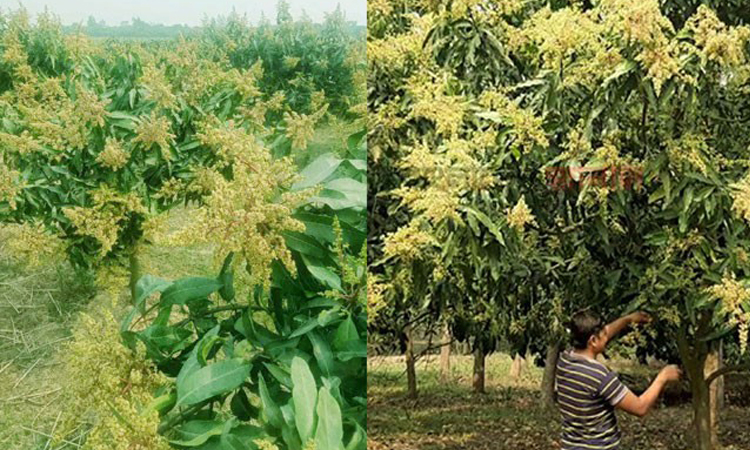News Flash
News Flash

By Md. Aynal Haque
RAJSHAHI, Feb 7, 2025 (BSS) - As winter bids farewell, many mango trees in the Rajshahi region, famous for producing the seasonal delicious mango fruit, have started flowering.
The abundant blooming of mango trees at this stage indicates an excellent output of the seasonal fruit this season, if the climatic conditions remain favorable until the harvest, said Principal Scientific Officer of Fruit Research Station (FRS) Dr. Shafiqul Islam, adding that the current weather condition is favourable for the blossom in mango trees.
He said hundreds of thousands of mango trees have already bloomed, adorning eye-catching looks with abundant flowers. Flowering in mango trees began in mid-January, and it will continue until mid-March, he added.
New mango orchards, especially of Amrapali, BARI mango-3, and 4 varieties, are rapidly increasing in the districts, said agriculturists.
Naogaon was long known for paddy cultivation, but last year it became the highest mango-producing district, surpassing the mango capital of Chapainawabganj.
Dr. Islam said Chapainawabganj still has the highest amount of land covered by mango orchards, but Naogaon saw a one-and-a-half-times increase in its mango farm acreage annually over the last 10 years, according to Department of Agricultural Extension (DAE) data.
The area covered by mango orchards in Naogaon increased by 14,925 hectares in the period, while the increase was 9,520 hectares in Chapainawabganj.
Mango farming is not only increasing but also changing as well. Instead of creating mango orchards for a hundred years or more, farmers are targeting to flourish their mango orchards within only 10 years.
Golam Mourtoza, 55, a mango trader of Baneswar village under Puthiya upazila, said that currently farmers are seen very busy nursing mango trees to protect the flower from dropping.
Usually, he added, blooming of mangoes is seen to occur during the last week of January and continues till the middle of March.
Motaleb Hossain, a mango grower of Charghat upazila, said he has over 200 mango trees in his orchard. He has cultivated a large variety of mangoes this season. He is expecting a handsome profit from the early blooming of mango trees this year.
Normally, 10 mango trees are planted in one bigha of land, but in the new farming method, farmers can plant up to 200 trees in the same space, said Md Nuruzzaman, a mango grower of Porsha upazila of Naogaon.
"These trees will bear fruit for 10 years or less, and then we have to uproot them and replant."
The growth of mango orchards is the highest in the two Naogaon upazilas-Porsha and Sapahar. They have 72 percent of the orchards of the district, said sources at the DAE.
Meanwhile, around 45 to 50 percent mango trees have already sprouted in Chapainawabganj, while 60 to 65 percent in Rajshahi, as the remaining mango trees are expected to sprout by mid-March in some cases, he continued.
On behalf of the FRS, many of the grassroots mango farmers were imparted training to yield maximum output side by side with safe production after the best uses of modern technologies, Dr. Shafiqul Islam added.
Additional Director of the DAE Dr. Motaleb Hossain said the farmers have been caring and taking measures for making mango farming successful everywhere.
The farmers have been keeping contacts with the agriculture officers at the field levels to control the possible attacks by hoppers and some other pests on the mango flowers.
There are around 35 lakh mango trees of different ages on some 23 thousand hectares of land in the region, said the DAE officials.
The number of growing mango trees has been increasing in the region for the last couple of years. Mango, the leading seasonal cash crop of the north-western region, vitalizes the overall economy of Rajshahi, Naogaon and Chapainawabganj districts.
After witnessing the present climate condition, both the growers and the officials are very optimistic about the high yield of the seasonal fruit.
Abul Hossain, a farmer of Mazar Diar village in Paba upazila, said buds started appearing in mango trees this season before the end of winter.